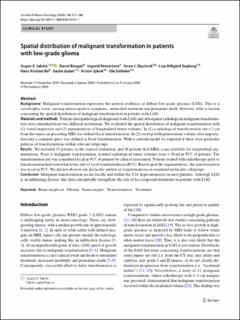| dc.contributor.author | Jakola, Asgeir S | |
| dc.contributor.author | Bouget, David Nicolas Jean-Marie | |
| dc.contributor.author | Reinertsen, Ingerid | |
| dc.contributor.author | Skjulsvik, Anne Jarstein | |
| dc.contributor.author | Sagberg, Lisa Millgård | |
| dc.contributor.author | Bø, Hans Kristian | |
| dc.contributor.author | Gulati, Sasha | |
| dc.contributor.author | Sjåvik, Kristin | |
| dc.contributor.author | Solheim, Ole | |
| dc.date.accessioned | 2020-09-29T08:53:42Z | |
| dc.date.available | 2020-09-29T08:53:42Z | |
| dc.date.created | 2020-01-12T16:30:03Z | |
| dc.date.issued | 2020 | |
| dc.identifier.issn | 0167-594X | |
| dc.identifier.uri | https://hdl.handle.net/11250/2680181 | |
| dc.description.abstract | Background
Malignant transformation represents the natural evolution of diffuse low-grade gliomas (LGG). This is a catastrophic event, causing neurocognitive symptoms, intensified treatment and premature death. However, little is known concerning the spatial distribution of malignant transformation in patients with LGG.
Materials and methods
Patients histopathological diagnosed with LGG and subsequent radiological malignant transformation were identified from two different institutions. We evaluated the spatial distribution of malignant transformation with (1) visual inspection and (2) segmentations of longitudinal tumor volumes. In (1) a radiological transformation site < 2 cm from the tumor on preceding MRI was defined local transformation. In (2) overlap with pretreatment volume after importation into a common space was defined as local transformation. With a centroid model we explored if there were particular patterns of transformations within relevant subgroups.
Results
We included 43 patients in the clinical evaluation, and 36 patients had MRIs scans available for longitudinal segmentations. Prior to malignant transformation, residual radiological tumor volumes were > 10 ml in 93% of patients. The transformation site was considered local in 91% of patients by clinical assessment. Patients treated with radiotherapy prior to transformation had somewhat lower rate of local transformations (83%). Based upon the segmentations, the transformation was local in 92%. We did not observe any particular pattern of transformations in examined molecular subgroups.
Conclusion
Malignant transformation occurs locally and within the T2w hyperintensities in most patients. Although LGG is an infiltrating disease, this data conceptually strengthens the role of loco-regional treatments in patients with LGG. | en_US |
| dc.language.iso | eng | en_US |
| dc.publisher | Springer Verlag | en_US |
| dc.rights | Navngivelse 4.0 Internasjonal | * |
| dc.rights.uri | http://creativecommons.org/licenses/by/4.0/deed.no | * |
| dc.title | Spatial distribution of malignant transformation in patients with low-grade glioma | en_US |
| dc.type | Journal article | en_US |
| dc.type | Peer reviewed | en_US |
| dc.description.version | publishedVersion | en_US |
| dc.source.journal | Journal of Neuro-Oncology | en_US |
| dc.identifier.doi | 10.1007/s11060-020-03391-1 | |
| dc.identifier.cristin | 1770901 | |
| dc.description.localcode | © The Author(s) 2020 Open Access This chapter is licensed under the terms of the Creative Commons Attribution 4.0 International License (http://creativecommons.org/licenses/by/4.0/), | en_US |
| cristin.ispublished | true | |
| cristin.fulltext | original | |
| cristin.qualitycode | 1 | |

